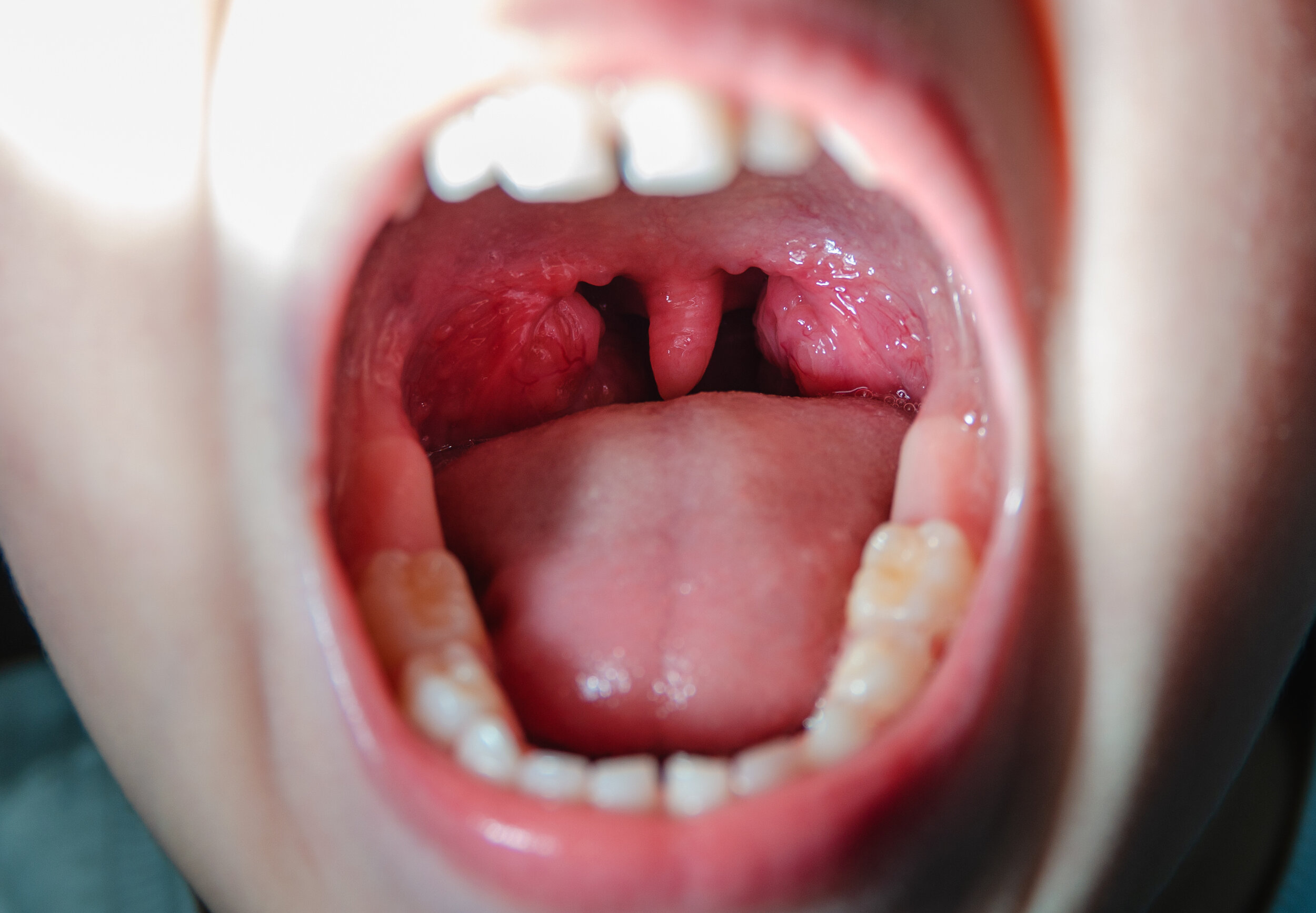Treatments: Tonsils, Adenoids, and Pharyngitis
Infection of the throat, including tonsillitis and adenoiditis, is initially treated non-surgically. When severe, recurrent, or persistent, surgical treatment may be indicated. Tonsillectomy is the removal of the tonsils in the back of the throat. Adenoidectomy is removal of the adenoid pad of tissue, which is the same type of tissue as tonsils, but located at the anatomic corner between the back of the nose and the top of the throat. A recommendation for tonsillectomy, adenoidectomy, or both is made on the basis of a large body of research as it relates to a given individual patient.
Group A strep testing was positive.
Treatments for tonsillitis, adenoiditis, and Pharyngitis (sore throat) including non-surgical
Since the tonsils and adenoids are a part of the throat (pharynx), tonsillitis and adenoiditis may be considered special subtypes of pharyngitis. Of these infections, the majority are viral, and resolve after a few days. If symptoms persist after a few days, the statistical chances of the infection being bacterial increases, and then use of antibacterial antibiotics may be appropriate. Strep throat (technically, infection of Group A beta-hemolytic Streptococcal bacteria, “GAS”) is a special consideration, though. While GAS pharyngitis is a self-limiting infection that will usually resolve within a week without medication, antibiotics may reduce the length and severity of the illness and reduce the risk of certain rare but serious complications, including rheumatic heart disease, kidney damage, and a significant rash (called scarlet fever). Testing for strep throat can be done with a swab. Immediate results are available with a rapid strep test (RST), which are very accurate if positive (95+% accurate) but only 65-94% accurate if negative, depending on which specific RST technology is used. The most accurate way of diagnosing strep throat is with a culture, in which the swab material is allowed to grow in a lab and the presence of GAS would be easily apparent, but the culture results take about 48 hours. Since 5-20% of individuals carry GAS in their throats without symptomatic infection, however, the presence of GAS in an individual with pharyngitis does not prove that this organism is responsible for the infection. Generally, when either the rapid strep test or the culture are positive in the setting of a sore throat, the decision is made to treat with antibiotics (such as amoxicillin or clindamycin). Recurrent strep throat may be due to repeatedly contracting the infection from an outside source, which may be one or more individuals at a school, for example. Alternatively, recurrent strep throat may be due to the long-term presence of GAS in the throat that periodically worsens, causing symptoms, and then lessens without complete resolution, only to repopulate again, causing symptoms. In this scenario, the tonsils and adenoids tend to be the location where the bacteria persists between symptomatic episodes. This is why recurrent strep throat without an apparent other source, may benefit from tonsillectomy and adenoidectomy.
tonsillectomy
Removing one or both tonsils (technically, the “palatine tonsils”) is a procedure done through the open mouth with the patient asleep. Tonsil tissue consists of immune system cells, but their role in our health appears to be complete very early in life, possibly even before birth, so we do not experience any loss of immune system function after their removal. Reasons for undergoing tonsillectomy include:
Infections: recurrent tonsillitis infections that come and go frequently, a long-standing infection, or. a severe infection, such as one leading to abscesses. Recurrent strep throat (streptococcal pharyngitis) is a specific bacterial infection in which the tonsils are sometimes the cause, and sometimes not. See also the section on tonsil stones, below.
Breathing: tonsils take up space, and removing tonsils that contribute to throat airway blockage can help breathing problems, most commonly airway problems during sleep.
Tumors: Asymmetry of the tonsils may raise the suspicion for cancer, especially when other factors are suggestive of cancer. Removing one or both tonsils is a way to identify whether cancer is present in a tonsil or not.
Other: Sometimes, tonsils are removed for difficulty swallowing, halitosis (bad breath), or tonsilloliths.
Here is a video demonstrating tonsillectomy and adenoidectomy.
adenoidectomy
Composed of the same type of immune system tissue as the tonsils, the adenoids are a single pocket of tissue in the midline of the nasopharynx, situated between the Eustachian tubes that connect the throat to the ears. Reasons for undergoing adenoidectomy include:
Infections: The adenoids are known to be the “cesspool of the throat,” because many types of bacteria tend to persist here. When this causes problems, such as frequent ear infections (despite prior use of PE tubes in the ears), chronically draining nostrils (especially in young children), or associated with tonsil infections, removal of the adenoids may be recommended.
Breathing: adenoids also take up space, and their anatomic position is such that enlarged (hypertrophic) adenoids can block the nasal airway. This may force one to mouth breathe, which in itself is a nuisance, but it may also contribute to a more significant airway problem, most commonly worst during sleep, ranging from snoring to sleep apnea.
Tumors: An uncommon type of cancer named for it’s location, nasopharyngeal carcinoma, originates from the adenoids or the throat lining in this area. If needed for diagnosis, removal of some or all of the adenoid tissue to examine it for tumor may be performed.
TONSIL STONES (TONSILLOLITHS, TONSILITHS)
Tonsil stones are collections of food, dead cells, and mucus that get trapped in the crypts of tonsils. They tend to harden and allow bacteria to thrive, sometimes causing inflammation and tonsillitis, pain and/or bad breath. The best treatment for tonsil stones that cause symptoms is to gently remove them as needed. There are many techniques for removing tonsil stones, including using a finger, the back of your toothbrush, or with a WaterPik type device that has a low-pressure setting, such as the Waterpik Acquarius WP-660 and the H2Ofloss HF-9 Whisper products. Tonsillectomy is a fairly extreme treatment for tonsil stones used when symptoms are severe (such as recurrent or chronic tonsillitis) and other treatments have failed. Here’s a light-hearted video explaining tonsil stones in greater detail.
Alternatives to tonsillectomy ± adenoidectomy for obstructive reasons
When tonsils and/or adenoids are thought to be large enough to cause blockage of the airway, as with sleep disordered breathing (including suspected or known obstructive sleep apnea), surgical removal of the tonsils and/or adenoids may be offered by your surgeon. Alternatives to undertaking tonsillectomy and/or adenoidectomy may include the following:
When the diagnosis of sleep disordered breathing or obstructive sleep apnea is suspected clinically, one may opt to undergo a diagnostic sleep study to either confirm or refute the clinical impression. If such a sleep study were to show no sleep disordered breathing, then tonsillectomy and/or adenoidectomy may be unnecessary.
When obstructive sleep apnea is confirmed with a sleep study, alternative options for treating obstructive sleep apnea are detailed here. Keep in mind that children with obstructive sleep apnea and large tonsils and/or adenoids, with few exceptions, are usually cured by tonsillectomy ± adenoidectomy and children may not tolerate alternative treatments.
This page








